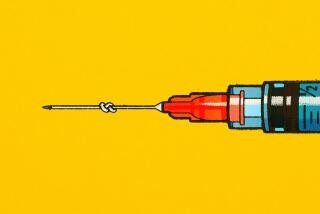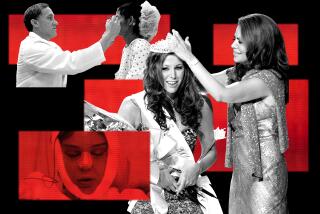Undo-plasties swell in a nip-tuck world
- Share via
After two nose jobs and thousands of dollars, Debra Dunn hated her face so much that she avoided mirrors, didn’t want to leave the house and hid behind her long hair any time she had to go out in public.
“Every time I saw myself, I wanted to punch myself in the nose to make it all go away,” said the 40-year-old New Yorker, referring to the five years that followed a cosmetic surgery intended to even out a bump on her nose from a childhood injury. “I just kept thinking, ‘Why did I do this to myself?’ ”
Doctor after doctor told Dunn her new nose was lovely. “Anyone would kill for a cute little nose like that,” she remembers many of them saying, despite the fact her new nose was so narrow that it whistled when she breathed. But Dunn deeply regretted messing with what nature had given her and felt she no longer bore any resemblance to herself.
Desperate, Dunn eventually spent more than three times the amount of her original surgery in an attempt to rebuild her nose to resemble the one she’d been born with.
“I don’t think you can ever go completely back to square one,” she said. “But for the most part, I now look like myself again.”
As plastic surgery has become increasingly common in America -- some 16 million procedures were performed in 2007 -- so has the consumer backlash.
Thousands of patients find themselves so displeased with the results of their surgeries that they are paying top dollar to undo what they had done. Such procedures are so high in demand that some doctors promote themselves as “revision plastic surgeons” and devote up to 50% of their practices to such cases. The surgeries have earned their own nickname in the trendy nip-tuck world: Undo-plasties.
“I’d say at this point that one out of about every two or three procedures I do is a revision surgery,” said Dr. Andrew Jacono, chief of facial plastic and reconstructive surgery at North Shore University Hospital in Manhasset, N.Y.
If Hollywood’s Joan Rivers cheekbones, Botox parties and Angelina Jolie-inspired lip injections led the nation into its plastic surgery craze, it also has pioneered the developing trend of regretting results.
Rocker Courtney Love recently wrote on her MySpace page that she hated her face-lift and wanted to go back to “the mouth God gave me.”
Porn star Jenna Jameson had her breast implants removed last year, saying, “Why don’t I be who I am?”
Singer Julio Iglesias went public last year about plastic surgery he had on his sagging neck and jaw line, calling it the “worst thing” he’d ever done.
Actress Annabelle Gurwitch recently contributed a heartfelt commentary on National Public Radio in which she agonized over her choice to follow the Hollywood crowd to the plastic surgeon’s operating table. Instead of loving her new, youthful face, she spoke of missing the bags under her eyes that had taken her “40 years to accumulate” and of feeling “like a sheep.”
“Have I flouted nature and tampered with an essential, defining part of my being?” she asked. “People are saying I look prettier, while I think I just look more standardized, like a new house where all the corners meet.”
Jacono said the idea of feeling standardized was exactly what bothered so many of his clients. He said the combination of plastic surgery’s popularity and the fact that so many doctors were jumping into the largely unregulated profession without specialized training had resulted in millions of “cookie cutter” surgeries that he called “the Dr. Jones rhinoplasty and the Dr. Smith face-lift.”
“Everyone kind of ends up looking the same,” he said, adding that patients from California, Wyoming, Italy, England and Ireland have recently come to him to revise surgeries they hate.
Jacono said many plastic surgeons not only tend to do all noses and face-lifts alike but also do far more aggressive procedures than clients envision. He said clients often tell him they only wanted to look like a younger version of themselves but “came out looking like they had been trapped in a wind tunnel.” Patients like Dunn who hate the results of their initial plastic surgeries often become reclusive, unwilling to leave home. Jacono said by the time many of them come to him, they are profoundly depressed and ashamed.
Kathy J. Kater, a St. Paul psychotherapist who specializes in body image disorders, said such reactions make sense.
“There is a human hunger to be our most authentic self,” she said. “Such dramatic surgeries can make people feel as though their permanent self is not their genuine self -- at least on the outside. That can lead to a real feeling of internal discontent or even a very deep grief for a self who now seems to have disappeared.”
Kater said she had some clients who had spiraled into deep depression after having weight-loss surgeries and then regaining the weight.
“They feel like even bigger failures at that point and regret doing the surgery in the first place,” she said.
Since Jacono reconstructed Dunn’s nose -- not an easy process because so much tissue and cartilage had been removed in her first nose job -- she said she had returned to her former, outgoing self. She works outside the home again and doesn’t try to shrink behind her hair.
“I feel like I have myself back, and my life back,” she said.
When asked whether this new wave of revision surgeries is just another symptom of the nation’s addiction to plastic surgery, Jacono discounted the theory.
“A lot of these people come to me completely reclusive because they are so inhibited by the person they’ve been turned into,” he said. “And after I restore the face they want to them, they never have another plastic surgery again.”
More to Read
Sign up for Essential California
The most important California stories and recommendations in your inbox every morning.
You may occasionally receive promotional content from the Los Angeles Times.










